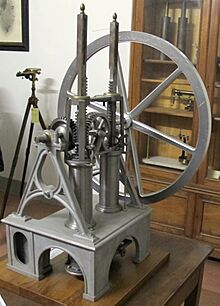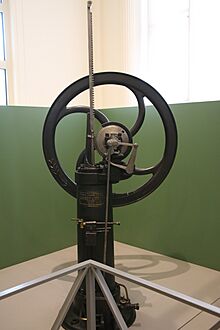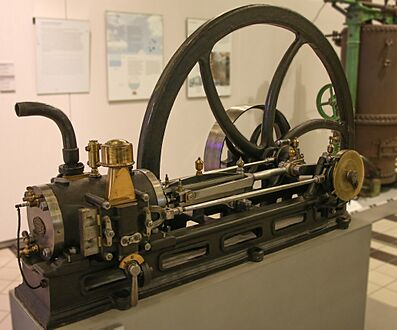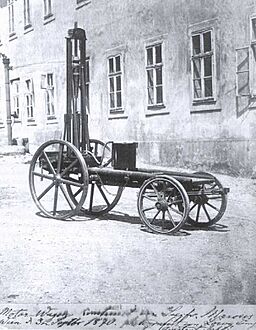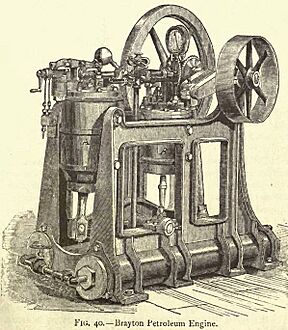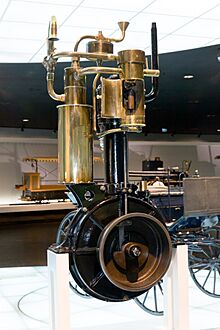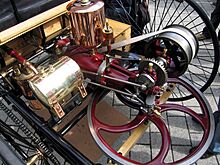History of the internal combustion engine facts for kids
Internal combustion engines are amazing machines that power many things we use every day, like cars, motorcycles, and even some airplanes! They work by burning fuel inside a special chamber, which creates hot gases that push parts of the engine to make it move.
The idea for these engines goes way back, even to ancient China, where people invented the first rocket engines between the 10th and 13th centuries. Later, in the 1700s, inventors started trying to create engines that burned fuel inside, similar to how steam engines (which burn fuel outside) worked.
In 1791, an English inventor named John Barber patented an idea for a gas turbine. Just a few years later, in 1794, Robert Street created an internal-combustion engine that was the first to use liquid fuel, like petroleum. In 1807, French engineers Nicéphore and Claude Niépce built a prototype engine called the Pyréolophore. It used controlled dust explosions to power a boat on a river in France! The same year, Swiss engineer François Isaac de Rivaz built an engine powered by hydrogen and oxygen. He even put it on a four-wheeled wagon and drove it 100 meters in 1813, making it the first car-like vehicle known to be powered by an internal-combustion engine.
In 1823, Samuel Brown patented an internal combustion engine that was used in factories. He even showed off a boat and a carriage powered by his engine. A big step forward happened in 1853 when Italian engineers Eugenio Barsanti and Felice Matteucci invented what many consider the first true internal combustion engine. Their patent was granted in London in 1854.
Then, in 1860, Belgian engineer Jean Joseph Etienne Lenoir made a gas-powered engine. In 1864, Nicolaus Otto patented the first gas engine that was successful enough to be sold widely.
Later, in 1872, George Brayton invented the first commercial liquid-fueled internal combustion engine. In 1876, Nicolaus Otto, working with Gottlieb Daimler and Wilhelm Maybach, patented the important four-stroke engine. This design is still used in many engines today! In 1879, Karl Benz patented a reliable two-stroke gas engine. By 1892, Rudolf Diesel developed the first compression ignition engine, which we now call the diesel engine. In 1954, German engineer Felix Wankel patented a unique "pistonless" engine that spins instead of using up-and-down pistons.
The first rocket powered by liquid fuel was launched in 1926 by Robert Goddard. The Heinkel He 178 became the world's first jet aircraft in 1939, followed by other types of jet engines like the ramjet in 1949 and the scramjet in 2004.
Contents
Early Ideas: Before 1850
Before 100 AD, the fire piston was invented in Southeast Asia. This simple device uses air compression to create heat and light a fire. It even inspired the Diesel engine, which also uses compression ignition (meaning it lights the fuel by squeezing it, not with a spark).
From the 10th to 13th centuries, the fire arrow, a type of rocket engine powered by gunpowder, was invented in China.
In the late 1600s, Dutch inventor Christiaan Huygens built a prototype engine that used gunpowder. In the 1780s, Italian chemist Alessandro Volta invented an "electric pistol" that used an electric spark to ignite hydrogen gas. This might be the first example of a spark-ignition engine, where a spark lights the fuel.
In 1791, British inventor John Barber described the idea for a gas turbine engine. In 1794, Robert Street built an engine that used gas vapors and an external flame to ignite the fuel. Another gas engine was patented by Thomas Mead that same year.
In 1807, French inventors Claude Niépce and Nicéphore Niépce built one of the first working internal combustion engines, the Pyréolophore. It used controlled dust explosions to power a boat on the Saône river in France. In the same year, Swiss engineer François Isaac de Rivaz built the hydrogen-fueled De Rivaz engine and put it on a wheeled carriage, possibly creating the first car. This engine used spark-ignition, like Alessandro Volta's earlier design.
In 1823, British engineer Samuel Brown patented a gas vacuum engine. One of his engines was used to pump water in London for several years. In 1826, American inventor Samuel Morey received a patent for a "gas or vapor engine" that included the first known design for a carburetor, a device that mixes fuel and air.
Big Steps: 1850–1879
Between 1853 and 1857, Italian mathematician Eugenio Barsanti and engineer Felice Matteucci patented the Barsanti–Matteucci engine. This engine used the vacuum created after an explosion to pull a piston down, making power.
In 1860, Belgian-French engineer Jean Joseph Etienne Lenoir invented a gas engine. It was similar to a steam engine but burned gas inside. Many of these engines were built and used in Paris, making it the first truly functional internal combustion engine.
In 1861, French engineer Alphonse Beau de Rochas described the idea for the four-stroke engine. This important concept involves four steps: intake, compression, power, and exhaust.
From 1864 to 1875, German inventor Siegfried Marcus built the first car powered by petrol (gasoline), which was a prototype handcart. In 1864, German engineers Eugen Langen and Nicolaus Otto created the first commercially successful internal combustion engine. It won a gold medal at the Paris Exhibition in 1867 because it used much less fuel than earlier engines.
In 1872, the first commercial liquid-fueled engine, called Brayton's Ready Motor, was patented by American engineer George Brayton. It started being sold in 1876.
A very important engine, the Otto Silent Engine, was built in 1876 by Nicholas Otto and his team. This engine was special because it compressed the air and fuel mixture before it burned, making it much more efficient. This engine used the four-stroke principle. In 1879, German engineer Carl Benz built a prototype two-stroke gas engine.
-
The 1860 Lenoir gas motor.
Modern Engines Take Shape: 1880–1899
In 1881, Scottish engineer Dugald Clerk patented the first commercially successful two-stroke engine design. This engine was also one of the first to use a supercharger, which helps force more air into the engine for more power.
In 1885, the Benz Patent-Motorwagen was built. Many people consider this to be the very first automobile (car). It was powered by a single-cylinder four-stroke engine. In the same year, German engineer Gottlieb Daimler built the Daimler Reitwagen, which is often seen as the first motorcycle. It used a high-speed engine called the Grandfather clock engine.
In 1888, Swedish engineer Gustaf de Laval invented the de Laval nozzle, which is used in many rocket and jet engines. Also in 1888, French inventor Félix Millet patented a rotary engine (different from the Wankel engine). This engine had five cylinders and was put in the rear wheel of a bicycle!
In 1889, German engineer Wilhelm Maybach built the first V engine, where cylinders are arranged in a "V" shape. The first engine block made of aluminum was also created in 1889.
In 1892, German engineer Rudolf Diesel wrote about his ideas for a new type of engine, which led to the invention of the diesel engine. In 1897, the first working diesel engine, designed by Rudolf Diesel, was built in Germany.
In 1897, Carl Benz built the first flat engine, where the cylinders are opposite each other, like a boxer's fists punching. This design is still used today. Also in 1897, German engineer Robert Bosch adapted an ignition magneto for use in car engines, which helps create the spark to ignite the fuel.
Engines in the 1900s
- 1902: The first V8 engine was built by French engineer Léon Levavasseur. It was used in early French airplanes.
- 1903: Norwegian inventor Ægidius Elling built the first gas turbine that could produce more power than it needed to run itself.
- 1905: The exhaust-driven turbocharger was patented by Swiss engineer Alfred Büchi. Turbochargers use exhaust gases to spin a turbine, which then pushes more air into the engine, making it more powerful.
- 1913: The design for a ramjet engine, a type of jet engine, was patented by French engineer René Lorin.
Engines in the Mid-1900s
- 1926: The first liquid-propellant rocket was built by American physicist Robert Goddard.
- 1930: The idea for a turbojet engine was patented by English engineer Frank Whittle. This engine had its first successful test in 1937.
- 1935: The first mass-produced diesel engine for a passenger car began production in Germany.
- 1937: The first turbojet engine prototype was built by German inventors Hans von Ohain and Ernst Heinkel. In 1939, a newer version of this engine made the first flight of a turbojet-powered aircraft.
- 1942: The German Messerschmitt Me 262 fighter-bomber airplane, powered by jet engines, completed its first flight.
- 1949: The first airplane powered by a ramjet engine completed a test flight.
- 1957: The first working prototype of the unique, pistonless Wankel engine (also called a rotary engine) was built by German engineer Felix Wankel.
- 1957: The first use of electronic fuel injection (EFI) in a production car happened with the American Bendix Electrojector system. This system precisely controls how much fuel goes into the engine.
Engines Today: 1980 to Present
- Early 1990s: Carburetors, which mix fuel and air, were mostly replaced by fuel injection systems in cars. Fuel injection is more precise and efficient.
- 1995: Toyota introduced VVT-i, a system that changes how engine valves open and close to improve performance and fuel economy.
- 2004: The first scramjet-powered airplane, the NASA X-43 prototype, completed a test flight. Scramjets are very advanced jet engines designed for extremely high speeds.
- 2006: Mercedes-Benz started using a special spraying method to make very smooth cylinder liners in their engines, which helps them last longer and work better.
- 2008: The BMW N63 was the first production engine to use a "Hot vee" turbocharged design, where the turbochargers are placed in the "V" shape of the engine.
- 2017: The 2019 Infiniti QX50 car became available with a turbocharged engine that could change its compression ratio. This means the engine can adjust how much it squeezes the fuel-air mixture, making it more efficient.
- 2021: At the COP26 conference, 24 countries agreed that by 2040, all new cars sold should be zero emission vehicles. This means they will effectively stop making cars powered by petrol or diesel.
- 2022: Hyundai announced that it would stop developing new internal combustion engines, focusing instead on electric vehicles.
- 2023: The first engine powered by ammonia for cars was developed by GAC Group. Ammonia is being explored as a cleaner fuel alternative.
See also
 In Spanish: Historia del motor de combustión interna para niños
In Spanish: Historia del motor de combustión interna para niños
- Timeline of heat engine technology
- Timeline of motor vehicle brands



